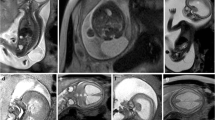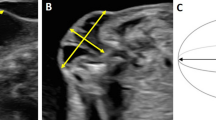Abstract
Purpose
Ultrasound is the primary method for prenatal identification of myelomeningocele and is critical to prognostication and treatment planning. No study has considered the degree of inaccuracy of prenatal US lesion level estimates and anatomic lesion level on postnatal imaging using the weighted kappa coefficient (κw), nor the impact of maternal BMI on agreement. We examined the accuracy of prenatal ultrasound lesion level estimation in a cohort of patients with myelomeningocele using κw and determined whether BMI influenced accuracy.
Methods
The study is a retrospective review including patients born 2011–2019 who had prenatal imaging and primary myelomeningocele closure at a single institution. Lesion levels from prenatal ultrasound and postnatal imaging studies were analyzed for agreement at exact level, within 1 level, and within 2 levels using κw. Maternal BMI was examined for correlation with accuracy.
Results
Fifty-seven patients met inclusion criteria. Mean BMI was 31.2. There was no association between maternal BMI and agreement at any level. Lesion level on prenatal ultrasound agreed with postnatal imaging to the exact level in 13 (22.8%) cases, within 1 level in 38 (66.7%) cases, and within 2 levels in 50 (87.7%) cases. Weighted kappa showed moderate agreement at exact level (κw = 0.494) and substantial agreement within 1 (κw = 0.761) and 2 levels (κw = 0.902).
Conclusion
Weighted kappa adds confidence for clinical decision making by accounting for accuracy. Prenatal ultrasound is a reliable and accurate method of determining lesion level with near-perfect agreement to postnatal imaging within 2 spinal levels. Maternal BMI may not influence lesion level determination after initial diagnosis.


Similar content being viewed by others
Availability of data and material
Raw data available upon request.
Code availability
Available on request.
References
Aaronson OS, Hernanz-Schulman M, Bruner JP, Reed GW, Tulipan NB (2003) Myelomeningocele: prenatal evaluation–comparison between transabdominal US and MR imaging. Radiology 227:839–843. https://doi.org/10.1148/radiol.2273020535
Appasamy M, Roberts D, Pilling D, Buxton N (2006) Antenatal ultrasound and magnetic resonance imaging in localizing the level of lesion in spina bifida and correlation with postnatal outcome. Ultrasound Obstet Gynecol 27:530–536. https://doi.org/10.1002/uog.2755
Coleman BG, Langer JE, Horii SC (2015) The diagnostic features of spina bifida: the role of ultrasound. Fetal Diagn Ther 37:179–196. https://doi.org/10.1159/000364806
Adzick NS, Thom EA, Spong CY, Brock JW, Burrows PK, Johnson MP, Howell LJ, Farrell JA, Dabrowiak ME, Sutton LN, Gupta N, Tulipan NB, D’Alton ME, Farmer DL, Investigators M (2011) A randomized trial of prenatal versus postnatal repair of myelomeningocele. N Engl J Med 364:993–1004. https://doi.org/10.1056/NEJMoa1014379
Farmer DL, Thom EA, Brock JW, Burrows PK, Johnson MP, Howell LJ, Farrell JA, Gupta N, Adzick NS, MoMS Investigators (2018) The management of myelomeningocele study: full cohort 30-month pediatric outcomes. Am J Obstet Gynecol 218:256.e251-256.e213. https://doi.org/10.1016/j.ajog.2017.12.001
Sherrod BA, Ho WS, Hedlund A, Kennedy A, Ostrander B, Bollo RJ (2019) A comparison of the accuracy of fetal MRI and prenatal ultrasonography at predicting lesion level and perinatal motor outcome in patients with myelomeningocele. Neurosurg Focus 47:E4. https://doi.org/10.3171/2019.7.Focus19450
Carreras E, Maroto A, Illescas T, Meléndez M, Arévalo S, Peiró JL, García-Fontecha CG, Belfort M, Cuxart A (2016) Prenatal ultrasound evaluation of segmental level of neurological lesion in fetuses with myelomeningocele: development of a new technique. Ultrasound Obstet Gynecol 47:162–167. https://doi.org/10.1002/uog.15732
Kollias SS, Goldstein RB, Cogen PH, Filly RA (1992) Prenatally detected myelomeningoceles: sonographic accuracy in estimation of the spinal level. Radiology 185:109–112. https://doi.org/10.1148/radiology.185.1.1523291
Munoz JL, Bishop E, Reider M, Radeva M, Singh K (2019) Antenatal ultrasound compared to MRI evaluation of fetal myelomeningocele: a prenatal and postnatal evaluation. J Perinat Med 47:771–774. https://doi.org/10.1515/jpm-2019-0177
Maxwell C, Glanc P (2011) Imaging and obesity: a perspective during pregnancy. AJR Am J Roentgenol 196:311–319. https://doi.org/10.2214/AJR.10.5849
Tsai PJ, Loichinger M, Zalud I (2015) Obesity and the challenges of ultrasound fetal abnormality diagnosis. Best Pract Res Clin Obstet Gynaecol 29:320–327. https://doi.org/10.1016/j.bpobgyn.2014.08.011
Taragin BH, Wootton-Gorges SL (2015) The spine: congenital and developmental conditions. In: Stein-Wexler R., Wootton-Gorges S., Ozonoff M. (eds) Pediatric Orthopedic Imaging. Springer, Berlin, Heidelberg. https://doi-org.foyer.swmed.edu/https://doi.org/10.1007/978-3-642-45381-6_3
Kim I, Hopson B, Aban I, Rizk EB, Dias MS, Bowman R, Ackerman LL, Partington MD, Castillo H, Castillo J, Peterson PR, Blount JP, Rocque BG (2018) Treated hydrocephalus in individuals with myelomeningocele in the National Spina Bifida Patient Registry. J Neurosurg Pediatr 22:646–651. https://doi.org/10.3171/2018.5.Peds18161
Kim I, Hopson B, Aban I, Rizk EB, Dias MS, Bowman R, Ackerman LL, Partington MD, Castillo H, Castillo J, Peterson PR, Blount JP, Rocque BG (2018) Decompression for Chiari malformation type II in individuals with myelomeningocele in the National Spina Bifida Patient Registry. J Neurosurg Pediatr 22:652–658. https://doi.org/10.3171/2018.5.Peds18160
Dashe JS, McIntire DD, Twickler DM (2009) Maternal obesity limits the ultrasound evaluation of fetal anatomy. J Ultrasound Med 28:1025–1030. https://doi.org/10.7863/jum.2009.28.8.1025
Author information
Authors and Affiliations
Corresponding author
Ethics declarations
Conflict of interest
On behalf of all authors, the corresponding author states that there is no conflict of interest.
Additional information
Publisher's Note
Springer Nature remains neutral with regard to jurisdictional claims in published maps and institutional affiliations.
Rights and permissions
About this article
Cite this article
Barnes, K.S., Singh, S., Barkley, A. et al. Determination of anatomic level of myelomeningocele by prenatal ultrasound. Childs Nerv Syst 38, 985–990 (2022). https://doi.org/10.1007/s00381-022-05469-9
Received:
Accepted:
Published:
Issue Date:
DOI: https://doi.org/10.1007/s00381-022-05469-9




